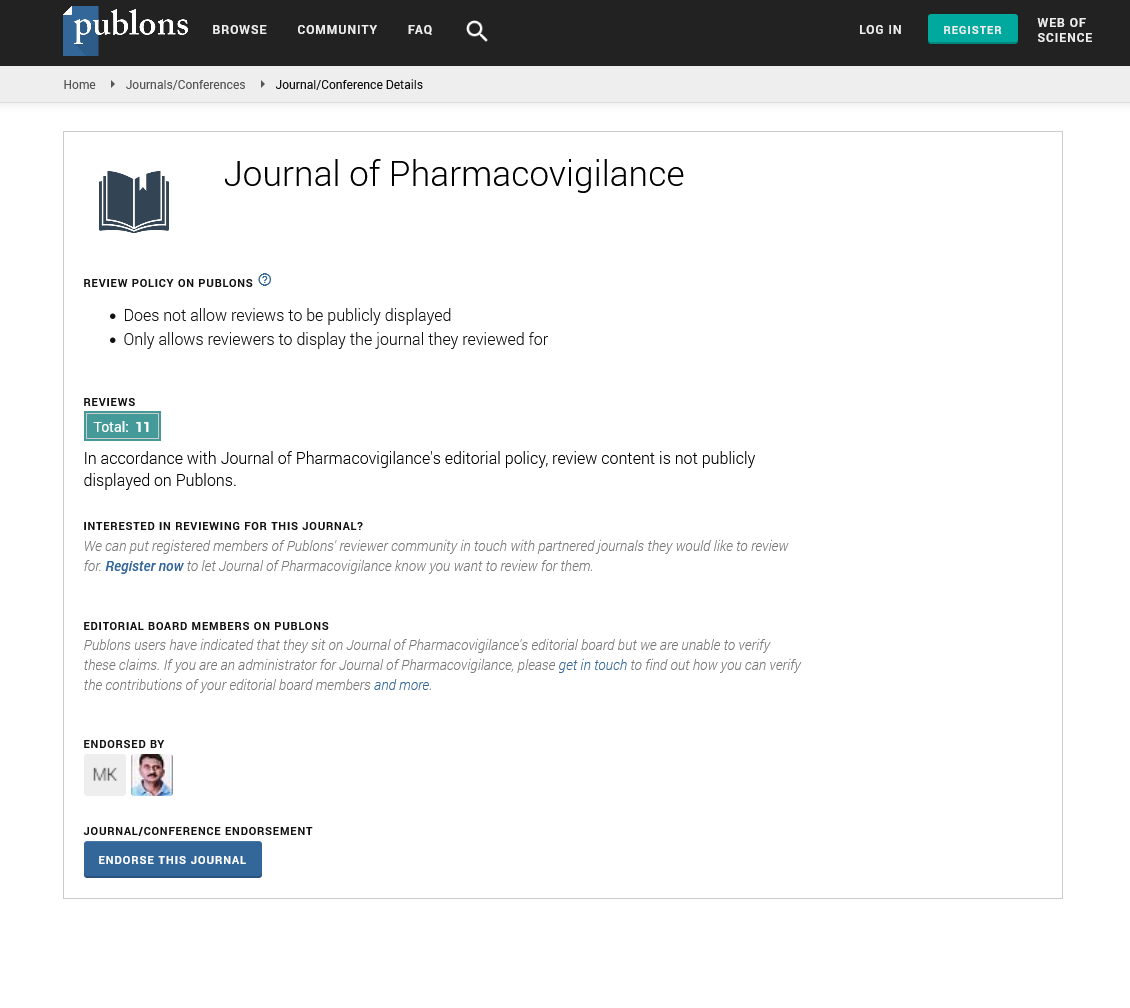Indexed In
- Open J Gate
- JournalTOCs
- The Global Impact Factor (GIF)
- RefSeek
- Hamdard University
- EBSCO A-Z
- OCLC- WorldCat
- Publons
- Euro Pub
- Google Scholar
Useful Links
Share This Page
Journal Flyer

Open Access Journals
- Agri and Aquaculture
- Biochemistry
- Bioinformatics & Systems Biology
- Business & Management
- Chemistry
- Clinical Sciences
- Engineering
- Food & Nutrition
- General Science
- Genetics & Molecular Biology
- Immunology & Microbiology
- Medical Sciences
- Neuroscience & Psychology
- Nursing & Health Care
- Pharmaceutical Sciences
Commentary - (2024) Volume 12, Issue 2
Strengthening the Public Health Impact of Medications: A Pharmacovigilance Perspective
Morino Hiroshi*Received: 29-May-2024, Manuscript No. JP-24-25982; Editor assigned: 31-May-2024, Pre QC No. JP-24-25982(PQ); Reviewed: 14-Jun-2024, QC No. JP-24-25982; Revised: 21-Jun-2024, Manuscript No. JP-24-25982(R); Published: 28-Jun-2024, DOI: 10.35248/2329-6887.24.12.476
About the Study
Medications are a fundamental of modern healthcare, significantly improving patient outcomes and quality of life. However, the potential for Adverse Drug Reactions (ADRs) necessitates strong Pharmacovigilance (PV) systems to ensure the safety and public health impact of medications. This manuscript explores current challenges in maximizing the public health impact of PV and proposes strategies for improvement. We discuss the critical roles of enhanced reporting from Healthcare Professionals (HCPs) and patients, efficient data analysis and signal detection, and effective communication with stakeholders.
The development and utilization of safe and effective medications are fundamental to public health progress. However, ensuring optimal medication safety requires continuous monitoring through PV, the science and activities related to the detection, assessment, understanding, and prevention of ADRs. Despite significant advancements in PV, there is an ongoing need to strengthen its impact on public health.
A significant barrier remains the underreporting of ADRs by both HCPs and patients. Factors contributing to this include lack of awareness about PV, time constraints in busy clinical settings, and unclear or cumbersome reporting procedures.
The vast amount of data generated by PV systems presents a challenge. Streamlining and standardizing data collection and analysis processes are crucial for enhancing the ability to identify potential safety signals from the noise. Advanced data analytics techniques, such as artificial intelligence and machine learning, potential for improving the efficiency and accuracy of signal detection.
Effective communication of PV findings to HCPs, patients, and policymakers is critical for informed decision-making regarding medication use. Current practices often fall short, with stakeholders lacking readily available, clear information about identified safety concerns and the benefits of strong PV systems.
Developing user-friendly, accessible, and electronic reporting platforms can significantly encourage HCP and patient participation. Educational initiatives targeted towards HCPs can highlight the importance of ADR reporting, while patient-facing campaigns can raise awareness about potential side effects and reporting mechanisms.
Leveraging artificial intelligence and machine learning algorithms can expedite data analysis and improve the sensitivity of signal detection. These methods can identify subtle patterns in large datasets that might be missed by traditional methods, leading to the earlier detection of potential safety issues.
Customizing PV communications to the specific needs of different stakeholders is significant for maximizing impact. For HCPs, concise safety updates highlighting potential ADRs and risk management strategies are essential. Patients benefit from clear, readily available information on medication safety, potential side effects, and the importance of reporting any adverse experiences. Policymakers require comprehensive reports outlining identified safety concerns and the proposed regulatory actions to ensure public health protection.
Conclusion
By addressing these challenges and implementing the proposed strategies, the public health impact of PV can be significantly enhanced. Strengthening reporting systems, leveraging data analytics, and prioritizing effective communication are key to ensuring the safety and efficacy of medications for all. Further research is needed to explore the integration of real-world data from electronic health records and patient registries into PV systems. This can provide a more comprehensive picture of medication safety in the real-world setting. Additionally, encouraginging international collaboration on PV practices and data sharing can significantly enhance the global understanding of ADRs and improve medication safety across borders.
Citation: Hiroshi M (2024) Strengthening the Public Health Impact of Medications: A Pharmacovigilance Perspective. J Pharmacovigil. 12:476.
Copyright: © 2024 Hiroshi M. This is an open-access article distributed under the terms of the Creative Commons Attribution License, which permits unrestricted use, distribution, and reproduction in any medium, provided the original author and source are credited.

